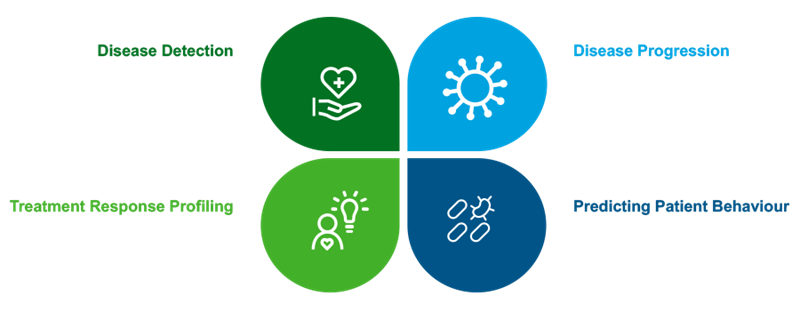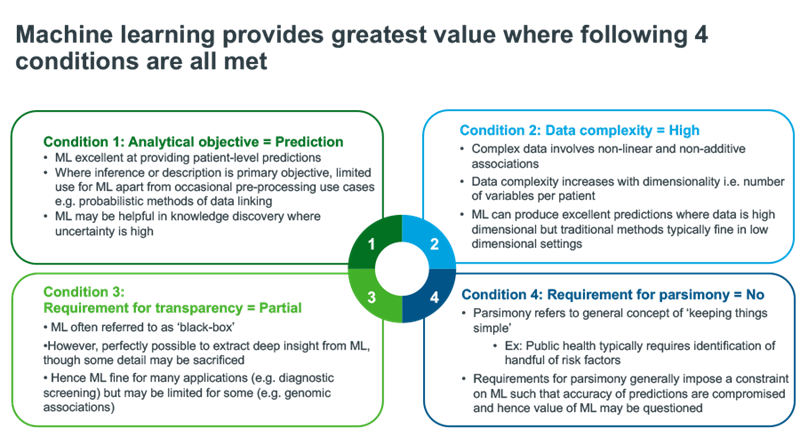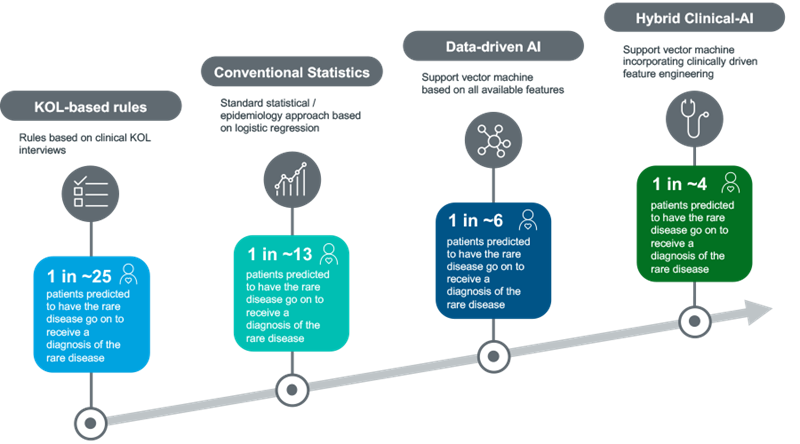











As described in our earlier blog, Artificial Intelligence (AI) and Machine Learning (ML) are powerful tools that can be leveraged within the Life Sciences industry to help advance research and development and further optimize an organization’s return on investment.
The generation of Real World Evidence has become increasingly important in healthcare with several stakeholders such as healthcare professionals, payers, and government stakeholders demanding evidence to facilitate their decision making. However, given the abundance of raw data and increasing complexity of datasets, it may be challenging to analyze the data and develop the insights needed. AI/ML can be employed to generate critical information to address problems that would otherwise be too time-consuming, inefficient, or even costly to solve.
IQVIA, a leader in AI/ML, has focused on four key areas where this technology can be used successfully:

Two examples of where AI/ML can be employed include rare disease detection and understanding the prevalence of a disease.
Opportunities and Challenges in Rare Disease Detection
Six to seven thousand rare diseases have been identified [1] and one in 12 Canadians have a rare disease [2]. Eighty per cent of rare diseases are genetic in origin [3] [4] and can take approximately 7.3 years to be diagnosed[4].
Due to the challenge of identifying and diagnosing rare diseases, patients often go untreated for several years, leading to a further deterioration of their health and overall quality of life. Additionally, even if patients are diagnosed, their disease could have progressed to a point where medication is no longer effective. This may result in the need for costly medical resources to help the patient with the ongoing management of their disease. Furthermore, ICD-10 codes may not be specific, and physicians may choose a code that best represents the symptoms. Thus, rare diseases are not specific in their codification and patients could potentially be grouped under one code. All of this can lead to subpar care for the patient and worsening outcomes.
Thus, it is critical that these patients be identified quickly so treatment can be initiated. The sooner this happens, the sooner their disease can be effectively managed, leading to better patient outcomes and a potential reduction in healthcare resource utilization.
However, given the ambiguous nature of diagnoses, it is challenging to identify these patients. This is where the strength of AI/ML can be applied. AI/ML can understand complex patterns, treatments, and associations that are not always obvious and develop an algorithm to accurately and efficiently identify these patients.
The figure below illustrates the conditions that must be met for AI/ML to yield the greatest value.

Case Study
Challenge - IQVIA worked with a client who wanted to understand if early disease detection algorithms could be used to find undiagnosed patients with a rare disease.
Solution - IQVIA conducted a study that compared both a hybrid Clinical-AI method with a fully data-driven AI and KOL-based knowledge. Data was leveraged from both primary and specialty care databases, encompassing approximately five million patients.
Results

Key takeaway - AI/ML combined with clinical knowledge yielded powerful results and was two-and-a-half times better than the standard epidemiological approach and five times better than KOL-based rules.
Challenges and Considerations - While AI/ML can be a powerful tool that can help with rare disease detection, there are some things that need to be considered. Given the low number of patients with a rare disease, the dataset from which to run the AI/ML needs to be very large in order to have enough data to develop an algorithm that accurately identifies patients with the disease, otherwise the algorithm runs the risk of identifying false positives, i.e. identifying patients who do not have the disease as having that particular rare disease. Second, the algorithm needs to be ‘trained’ on a sample from the same dataset as the applied dataset that will be used to detect patients with the rare disease. Appropriate strategies must be used to ensure that certain biases are not magnified e.g. an algorithm trained on an urban patient population may not be applicable to a non-urban population.
To further refine the use of AI/ML for rare disease detection, IQVIA tested pattern augmentation. Referred to as CONAN, Complementary Pattern Augmentation uses the concept of adversarial learning, in which the machine learns to differentiate between fake positives. First, a generator learns to create fake but likely patient samples. A disease detector then attempts to distinguish between the positive and negative patient samples. A method is established between the generator and the disease detector to train the disease detector. After this training, the disease detector can be used to detect rare disease patients. Running this process on real world data provided strong results. The full paper can be read here.
Determining prevalence of diseases
AI/ML has also been successfully used to determine the prevalence of diseases that may not necessarily be rare such as cardiovascular or immune diseases. Information can be generated to further fill any specific gaps in knowledge, allowing for a more holistic understanding of a disease.
Case Study
Challenge - A client wanted to understand the prevalence of chronic heart failure in the Canadian population as estimates were either from hospital-based data or databases with limited coverage.
Solution - IQVIA developed a predictive analytics model to predict heart failure prescription patterns using data from electronic medical records. The algorithm was tested using a dataset of approximately 15% of heart failure patients to establish the model’s accuracy, positive and negative predicted values, i.e. likelihood that the patient identified has the disease or does not have the disease. The algorithm was then applied to a national database to estimate the prevalence of heart failure.
Key takeaway - A total of 1,515 patients were included in the study to determine the prevalence of heart failure. The model had an overall accuracy of 80%, with 65% sensitivity, 89% specificity, 81% PPV and 79% NPV. When the algorithm was applied to patients aged ≥ 40 years, the study estimated approximately 650,000 patients which aligned with literature estimates of 590,416 and 626,199 patients.
Conclusion - The advent of AI/ML has opened a realm of possibilities for data mining and evidence generation to help solve complex questions. IQVIA is a global leader and with our expertise in Real World Evidence, we can help our clients continue to drive innovation, ultimately leading to positive patient outcomes.
References
[1] Orphanet, "About Rare Diseases," Orphanet Canada, 2017. [Online].
[2] "aBOUT cord," Canadian Organization For Rare Disorders, [Online]. [Accessed 2020].
[3] "The Global Challenge of Rare Disease Diagnosis".
[4] "Rare Disease by the Numbers," American's Biopharmaceutical companies, [Online].

